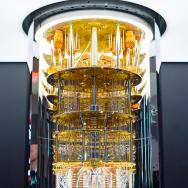A team of researchers at the University of Chicago recently embarked on the search of a lifetime—or rather, a search for the lifetime of long-lived supersymmetric particles.
Supersymmetry is a proposed theory to expand the Standard Model of particle physics. Akin to the periodic table of elements, the Standard Model is the best description we have for subatomic particles in nature and the forces acting on them.
But physicists know this model is incomplete—it doesn’t make room for gravity or dark matter, for example. Supersymmetry aims to complete the picture by pairing each Standard Model particle with a supersymmetric partner, opening up a new class of hypothetical particles to detect and discover. In a new study, UChicago physicists have uncovered limitations for what properties these superpartners, if they exist, could have.
“Supersymmetry really is the most promising theory we have for solving as many problems as possible in the Standard Model,” said Tova Holmes, assistant professor at the University of Tennessee, Knoxville, who worked on the experiment as a postdoctoral researcher at UChicago. “Our work fits into a larger effort at the Large Hadron Collider to reconsider how we search for new physics.”
The Large Hadron Collider, located in Europe at CERN, accelerates protons to nearly the speed of light before forcing them to collide. These proton-proton collisions produce a slew of additional particles where researchers hope to find new physics.
“But at the Large Hadron Collider, new physics events are extremely rare and difficult to identify in the debris of colliding particles,” said Prof. Young-Kee Kim, chair of the UChicago physics department and co-author of the study, an effort led entirely by women.
The UChicago team searched for the production of sleptons—hypothesized superpartners of the existing electron, muon, and tau leptons—using data collected in ATLAS, a particle detector at CERN. In the tested supersymmetry model, sleptons are theorized to have long lifetimes, meaning they can travel far before decaying into something detectable by ATLAS.
“One of the ways we can miss new physics is if the particle doesn’t decay promptly when it’s produced,” said Holmes. “Typically, we’re blind to long-lived particles in our searches, because we basically cut out anything that doesn’t look like a standard prompt decay in our detector.”
Sleptons are expected to eventually decay into their regular lepton partners. But unlike conventional decays, these leptons will be displaced, meaning they won’t point back to the original proton-proton collision point. It was this unique feature that physicists were hunting for.
In four years of collected ATLAS data, however, UChicago researchers found no displaced lepton events. That lack of discovery allowed them to set what is called a limit, ruling out a range of masses and lifetimes that long-lived sleptons might have.
“We are at least 95% sure that, should a slepton in this model exist, it doesn’t have the masses and lifetimes in the shaded portions of this plot,” said Lesya Horyn, newly minted PhD from UChicago who recently completed her dissertation on this measurement.
Does a null result disappoint the team? Not at all.
“Finding nothing tells you so much,” Horyn said. Knowing that long-lived sleptons don’t have certain masses and lifetimes informs researchers on where to focus future searches.
“From my point of view, this search was the number one thing theorists were calling out to have covered,” Holmes said. “It seemed like we could do it—and we did!”
The outcome has energized the team to push the boundaries even further. At some point in the next decade, the Large Hadron Collider will enter its periodic shutdown, leaving ample time for ATLAS hardware to be upgraded.
“This was a first pass at the analysis, so there are definitely places to improve,” Horyn said.
One pressing upgrade will be a revamp of the trigger system, which selects whether events should be saved or thrown away. The trigger is currently optimized to store decays from short-lived particles, not the long-lived sleptons central to this supersymmetry search.
More immediate improvements can be made without waiting for the shutdown.
“Future steps might include searching for the same model using more robust data from the next runs of the Large Hadron Collider,” said Xiaohe Jia, a graduate student at Harvard who worked on the experiment as a UChicago undergrad. Another route to explore, she said, could be using similar techniques to expand the long-lived particle search beyond just sleptons.
For now, the completion of the Standard Model remains a mystery, but the team is proud to have led a first search for this supersymmetry model in ATLAS.
“Discovering new physics is like finding a needle in a haystack,” Kim said. “Although we did not see anything in the current data, there is great opportunity for the future!”
Citation: “Search for displaced leptons in √ s = 13 TeV pp collisions with the ATLAS detector.” The ATLAS Collaboration, 6 October 2020. https://cds.cern.ch/record/2740685/files/ATLAS-CONF-2020-051.pdf
Funding: National Science Foundation.

